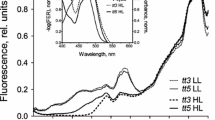Summary
The chlorophyll content and the fluorescence induction kinetics at two wavelengths (690 nm and 735 nm) have been measured in leaves of nine common broadleaf tree species during the autumnal chlorophyll breakdown. The ratio of the chlorophyll fluorescence maxima F690/F735 was determined at fluorescence maximum (fm) and at steady-state conditions (fs) by the laser-induced fluorescence emission using the two-wavelength fluorometer. The ratio F690/F735 increases with the leaf discolouring during the autumnal chlorophyll breakdown. The relationship between the chlorophyll content and the ratio F690/F735 can be expressed by a power function (curvilinear relationship) which is valid for all the species examined. In most cases the ratio F690/F735 measured in the upper leaf side is lower than that in the lower leaf side, but the trend is the same along the decreasing chlorophyll content. The ratio F690/F735 is always higher at maximum fluorescence than at steady-state fluorescence in the upper as well as lower leaf side and these values are well fitted in a linear correlation. This study confirms the usefulness of the ratio F690/F735 as a suitable non-destructive indicator of the in-vivo chlorophyll content, especially at medium and low chlorophyll content.
Similar content being viewed by others
References
Baker NR, Bradbury M (1981) Possible applications of chlorophyll fluorescence techniques for studying photosynthesis in vivo. In: Smith H (ed) Plants and the day light spectrum. Academic Press, London, pp 355–373
Buschmann C, Lichtenthaler HK (1988) Complete fluorescence emission spectra determined during the induction kinetic using a diode-array detector. In: Lichtenthaler HK (ed) Applications of chlorophyll fluorescence. Kluwer, Dordrecht, pp 77–84
Buschmann C, Lichtenthaler HK (1988) Reflectance and chlorophyll fluorescence signatures of leaves. In: Lichtenthaler HK (ed) Applications of chlorophyll fluorescence. Kluwer, Dordrecht, pp 325–332
Buschmann C, Schrey H (1981) Fluorescence induction kinetics of green and etiolated leaves by recording the complete in vivo emission spectra. Photosynth Res 1:233–241
French CS (1960) The chlorophylls in vivo and in vitro. In: Ruhland W (ed) Handbuch der Pflanzenphysiologie, vol 5/1. Springer, Berlin Heidelberg New York, pp 252–297
Holzwarth AR (1988) Time resolved chlorophyll fluorescence. In: Lichtenthaler HK (ed) Applications of chlorophyll fluorescence. Kluwer, Dordrecht, pp 21–31
Hák R, Lichtenthaler HK, Rinderle U (1990) Decrease of the chlorophyll fluorescence ratio F690/F730 during greening and development of leaves. Radiat Environ Biophys 25:329–336
Kautsky H, Hirsch A (1931) Neue Versuche zur Kohlenstoffassimilation. Naturwissenschaften 19:964
Kautsky H, Franck U (1943) Chlorophyllfluoreszenz und Kohlensäureassimilation. XI. Die Chlorophyllfluoreszenz vonUlva lactuca und ihre Abhängigkeit von Narkotika, Sauerstoffund Kohlendioxyd. Biochem Z315:139–232
Kocsányi L, Haitz M, Lichtenthaler HK (1988) Measurement of the laser-induced chlorophyll fluorescence kinetics using a fast acoustooptic device. In: Lichtenthaler HK (ed) Applications of chlorophyll fluorescence. Kluwer, Dordrecht, pp 99–107
Krause GH, Weiss E (1991) Chlorophyll fluorescence and photosynthesis: the basics. Ann Rev Plant Physiol Plant Mol Biol 42:313–349
Larcher W, Nagele M (1985) Induktionskinetik der Chlorophyllfluoreszenz unterkühlter und gefrorener Blatter vonRhododendron ferrugineum beim Übergang vom gefrierempfindlichen zum gefriertoleranten Zustand. Sitzungsberichte der Osterr Akademie der Wissenschaften Mathemat-naturwiss K1 Abt I 194:187–195
Lichtenthaler HK (1986) Laser-induced chlorophyll fluorescence of living plants. In: Proceedings of the International Geoscience and Remote Sensing Symposium (IGARSS), Zürich, vol III ESA, Scientific & Technical Publications Branch, Noordwijk, pp 1571–1579
Lichtenthaler HK (1987) Chlorophyll fluorescence signatures of leaves during the autumnal chlorophyll breakdown. J Plant Physiol 131:101–110
Lichtenthaler HK (1987) Chlorophylls and carotenoids: pigments of photosynthetic biomembranes. Methods Enzymol 148:350–382
Lichtenthaler HK, Buschmann C, Döll M, Fietz HJ, Bach T, Kozel U, Meier D, Rahmsdorf U (1981) Photosynthetic activity chloroplasts ultrastructure and leaf characteristics of high-light and low-light plants and of sun and shade leaves. Photosynth Res 2:115–141
Lichtenthaler HK, Burgstahler R, Buschmann C, Meier D, Prenzel U, Schöntal A (1982) Effect of high-light and low-light stress on composition function and structure of the photosynthetic apparatus. In: Marcelle R (ed) Effects of stress on photosynthesis. Junk, The Hague, pp 353–370
Lichtenthaler HK, Buschmann C, Rinderle U, Schmuck G (1986) Application of chlorophyll fluorescence in ecophysiology. Radiat Environ Biophys 25:297–308
Lichtenthaler HK, Buschmann C (1987) Chlorophyll fluorescence spectra of green bean leaves. J Plant Physiol 129:137–147
Lichtenthaler HK, Rinderle U (1988) The role of chlorophyll fluorescence in the detection of stress conditions in plants. CRC Crit Rev Anal Chem 19 [Suppl]: S29-S85
Lichtenthaler HK, Rinderle U (1988) Chlorophyll fluorescence as vitality indicator in forest decline research. In: Lichtenthaler HK (ed) Applications of chlorophyll fluorescence. Kluwer, Dordrecht, pp 143–149
Lichtenthaler HK, Rinderle U, Haitz M (1989) Seasonal variations in photosynthetic activity of spruces as determined by chlorophyll fluorescence. Ann Sci For 46 [Suppl] 483–489
Oegren E, Öquist G (1985) Effect of drought on photosynthesis, chlorophyll fluorescence and photoinhibition susceptibility in intact willow leaves. Planta 166:380–388
Papageorgiou G (1975) Chlorophyll fluorescence: An intrinsic probe of photosynthesis. In.: Govindjee (ed) Bioenergetics of photosynthesis. Academic Press, New York, pp 319–371
Potvin C (1985) Effect of leaf detachment on chlorophyll fluorescence during chilling experiments. Plant Physiol 78:883–886
Rinderle U, Lichtenthaler HK (1988) The chlorophyll fluorescence ratio F690/F735 as a possible stress indicator. In: Lichtenthaler HK (ed) Applications of chlorophyll fluorescence. Kluwer, Dordrecht, pp 189–196
Schreiber U (1983) Chlorophyll fluorescence yield changes as a tool in plant physiology. I. The measuring system. Photosynth Res 4:361–372
Schreiber U, Berry JA (1977) Heat-induced changes of chlorophyll fluorescence in intact leaves correlated with damage of the photosynthetic apparatus. Planta 136:233–238
Schreiber U, Schliwa U, Bilger W (1986) Continuous recording of photochemical and non-photochemical chlorophyll fluorescence quenching with a new type of modulation fluorometer. Photosynt Res 10:51–62
Sestak Z, Siffel P (1988) Changes in chloroplast fluorescence during leaf development. In: Lichtenthaler HK (ed) Applications of chlorophyll fluorescence. Kluwer, Dordrecht, pp 85–91
Author information
Authors and Affiliations
Rights and permissions
About this article
Cite this article
D'Ambrosio, N., Szabo, K. & Lichtenthaler, H.K. Increase of the chlorophyll fluorescence ratio F690/F735 during the autumnal chlorophyll breakdown. Radiat Environ Biophys 31, 51–62 (1992). https://doi.org/10.1007/BF01211512
Received:
Accepted:
Issue Date:
DOI: https://doi.org/10.1007/BF01211512



